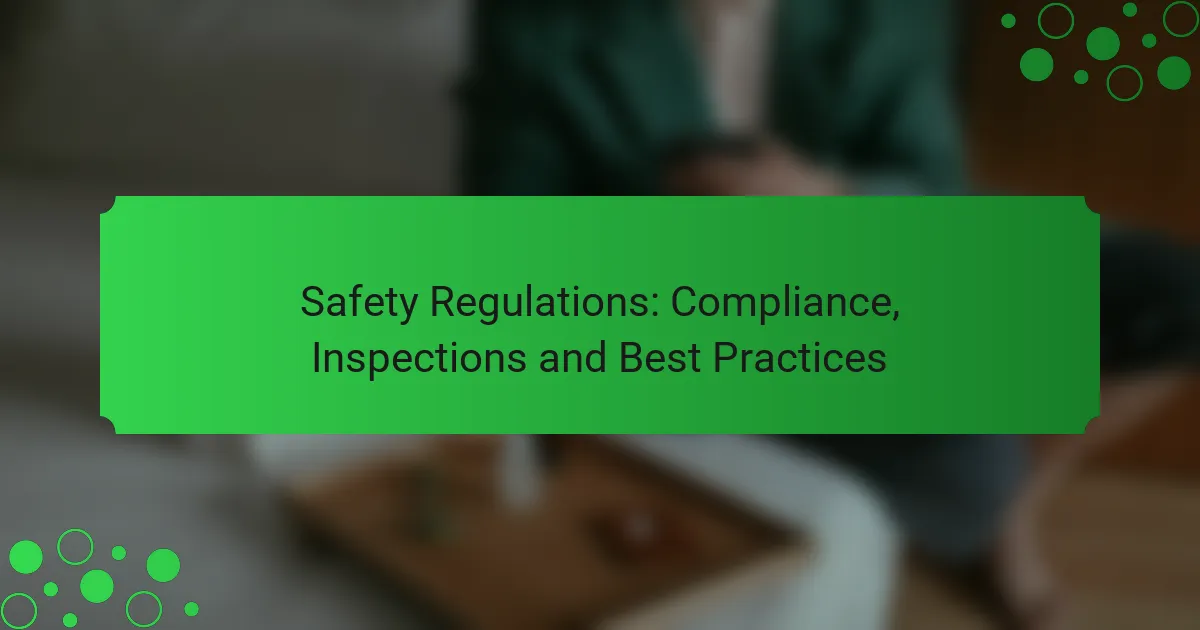Safety regulations in the United States are essential for protecting workers, the environment, and the public from potential hazards. Compliance with these regulations requires a proactive approach, including regular training and risk assessments, to foster a safer work environment. Implementing best practices for safety inspections, such as thorough assessments and third-party evaluations, further ensures adherence to these critical standards.
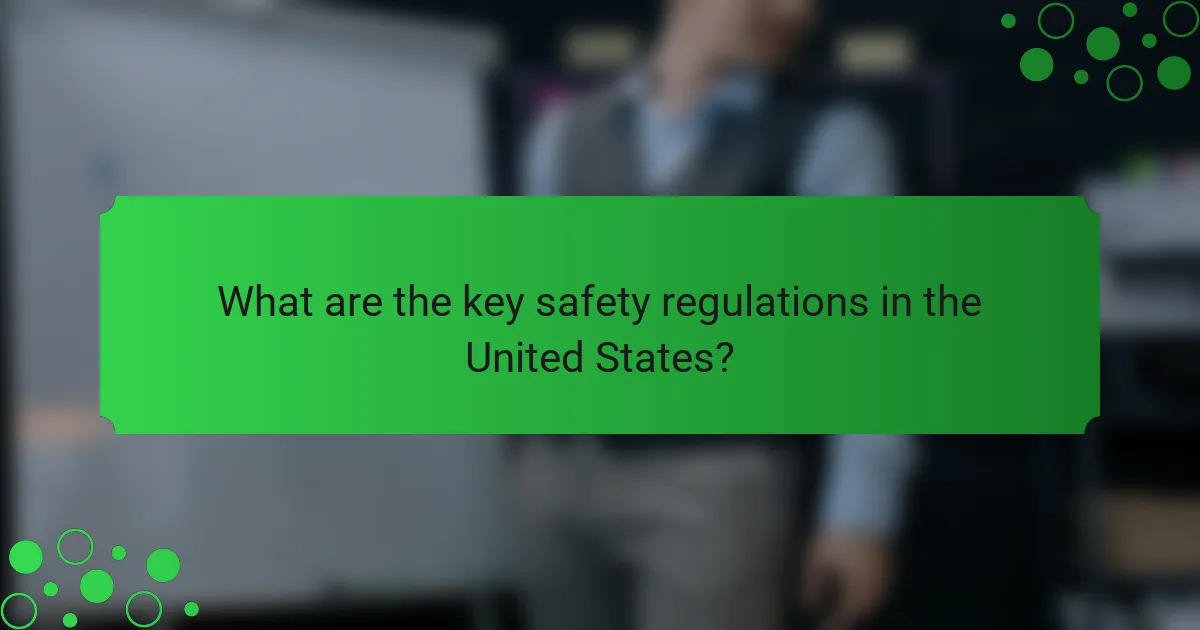
What are the key safety regulations in the United States?
The key safety regulations in the United States are designed to protect workers, the environment, and the public from hazards. These regulations include standards set by various federal agencies that govern workplace safety, environmental protection, and fire safety practices.
Occupational Safety and Health Administration (OSHA) standards
OSHA standards are crucial for ensuring workplace safety across various industries. They cover a wide range of topics, including hazard communication, personal protective equipment, and machine safety. Employers are required to comply with these standards to minimize risks and protect employees from workplace injuries.
To maintain compliance, businesses should conduct regular safety audits, provide employee training, and keep accurate records of workplace incidents. Failure to adhere to OSHA standards can result in significant fines and increased liability for employers.
Environmental Protection Agency (EPA) guidelines
The EPA guidelines focus on protecting the environment and public health by regulating pollutants and hazardous materials. These guidelines cover air and water quality, waste management, and chemical safety. Organizations must comply with these regulations to avoid environmental damage and legal repercussions.
Businesses should implement practices such as proper waste disposal, emissions monitoring, and adherence to chemical safety protocols. Regular training and updates on EPA regulations can help ensure compliance and promote sustainable practices.
National Fire Protection Association (NFPA) codes
The NFPA codes provide essential guidelines for fire safety in buildings and facilities. These codes address fire prevention, emergency planning, and the installation of fire protection systems. Compliance with NFPA codes is critical for reducing fire risks and ensuring the safety of occupants.
To comply with NFPA codes, organizations should conduct fire risk assessments, maintain fire suppression systems, and provide fire safety training for employees. Regular inspections and updates to fire safety plans are also necessary to meet evolving standards and protect lives.
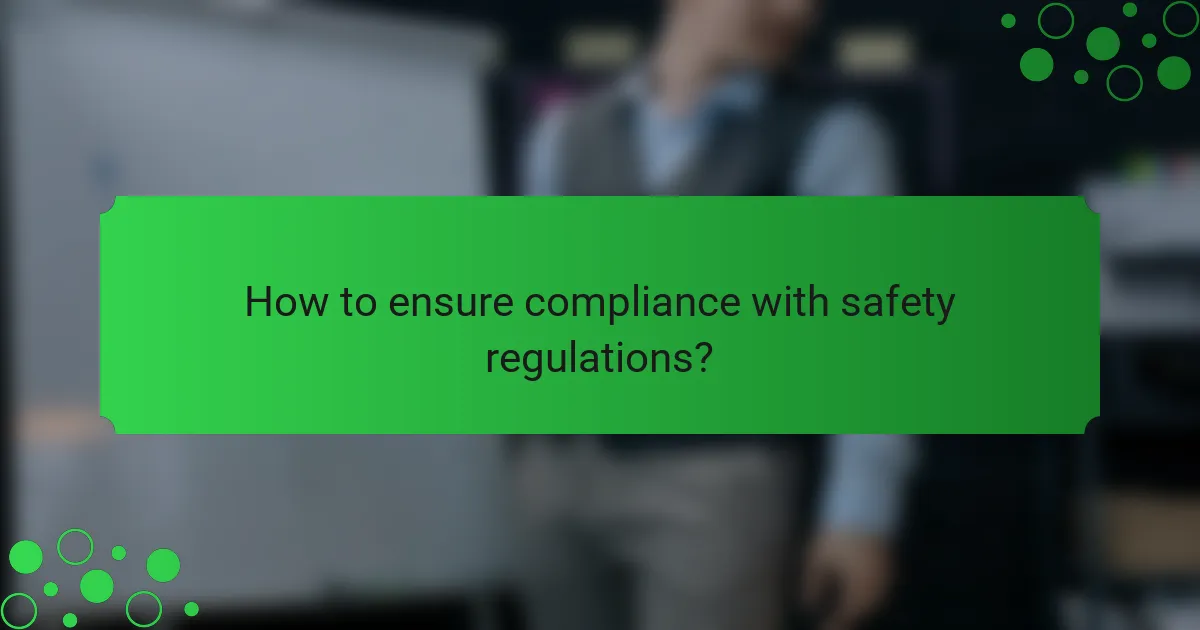
How to ensure compliance with safety regulations?
Ensuring compliance with safety regulations involves a proactive approach that includes regular training, risk assessments, and effective management systems. By focusing on these areas, organizations can create a safer work environment and meet legal requirements.
Regular training programs for employees
Implementing regular training programs is essential for maintaining compliance with safety regulations. These programs should cover relevant safety practices, emergency procedures, and the proper use of equipment. Aim for training sessions at least annually, with refreshers as needed.
Consider using a mix of training methods, such as hands-on workshops, online courses, and safety drills. This variety helps engage employees and reinforces learning, making it more likely that they will remember and apply safety protocols.
Conducting thorough risk assessments
Conducting thorough risk assessments is a critical step in ensuring compliance with safety regulations. This process involves identifying potential hazards in the workplace, evaluating the risks associated with those hazards, and determining appropriate control measures. Regular assessments should be conducted, ideally every six months or whenever significant changes occur in the workplace.
Utilize a systematic approach, such as the Hierarchy of Controls, to prioritize risk mitigation strategies. This can include eliminating hazards, substituting safer alternatives, implementing engineering controls, and providing personal protective equipment (PPE).
Implementing safety management systems
Implementing a safety management system (SMS) helps organizations systematically manage safety compliance. An effective SMS includes policies, procedures, and practices that promote a culture of safety and ensure adherence to regulations. Consider adopting frameworks like ISO 45001, which provides a structured approach to occupational health and safety management.
To maximize effectiveness, regularly review and update the SMS based on feedback, incident reports, and changes in regulations. Engaging employees in the process fosters a sense of ownership and accountability, which can enhance overall safety performance.
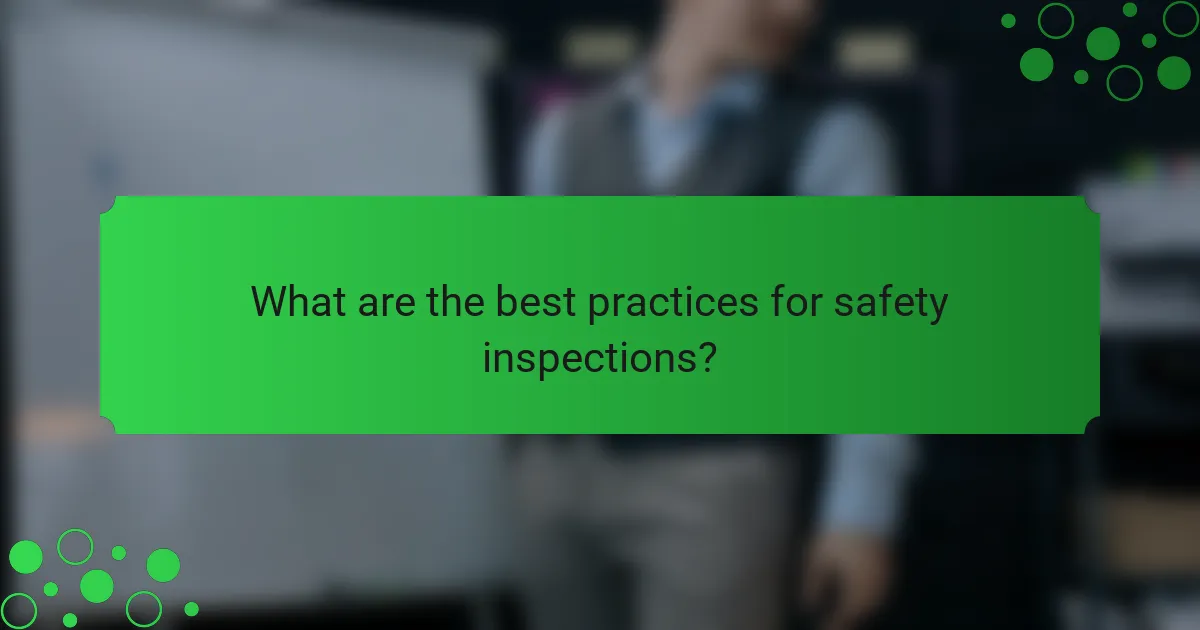
What are the best practices for safety inspections?
Best practices for safety inspections include conducting regular assessments, utilizing checklists for thoroughness, and engaging third-party auditors for unbiased evaluations. These strategies help ensure compliance with safety regulations and enhance overall workplace safety.
Scheduled routine inspections
Scheduled routine inspections are essential for maintaining safety standards. These inspections should occur at regular intervals, such as weekly or monthly, depending on the specific risks associated with the environment. Consistent scheduling helps identify potential hazards before they escalate into serious issues.
To implement effective routine inspections, create a calendar that outlines inspection dates and responsibilities. This proactive approach fosters a culture of safety and accountability among employees.
Utilizing checklists for consistency
Utilizing checklists during safety inspections promotes consistency and thoroughness. Checklists ensure that all critical areas are evaluated systematically, reducing the likelihood of overlooking important safety measures. They can be tailored to specific environments or regulations, making them versatile tools.
Consider including items such as equipment functionality, emergency exits, and personal protective equipment in your checklist. Regularly updating the checklist based on feedback and incident reports can further enhance its effectiveness.
Engaging third-party auditors
Engaging third-party auditors provides an objective perspective on safety compliance. These external experts can identify gaps in safety practices that internal teams may overlook due to familiarity. Their insights can lead to improved safety protocols and reduced liability.
When selecting a third-party auditor, ensure they have relevant experience and credentials in your industry. Their recommendations can help align your safety practices with industry standards and regulations, ultimately fostering a safer workplace environment.
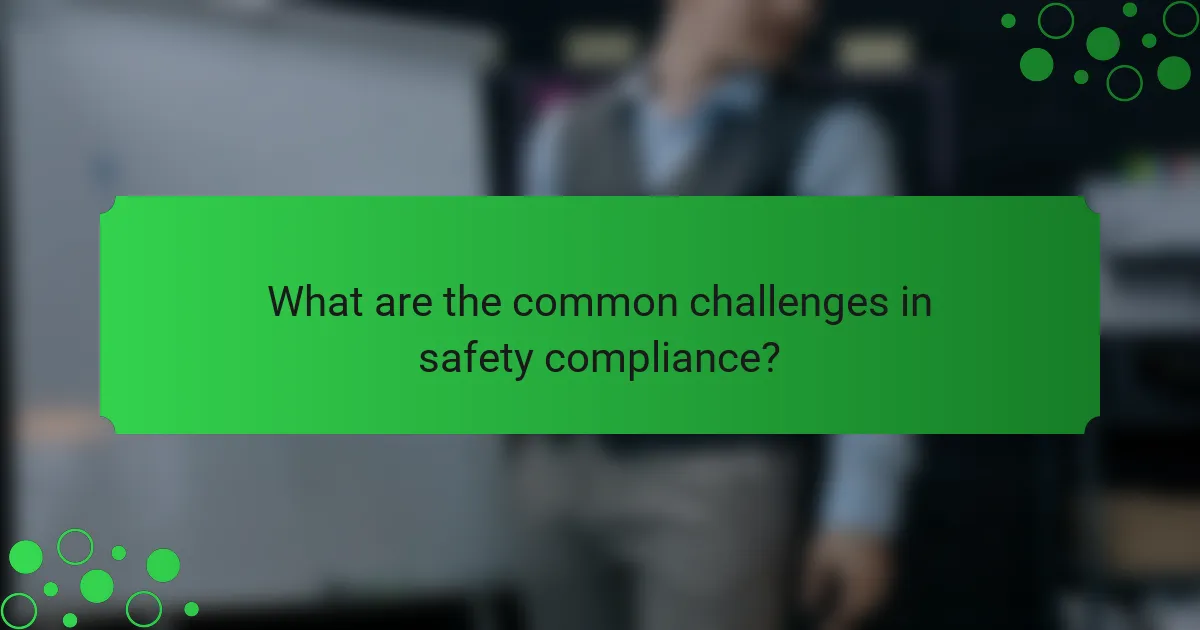
What are the common challenges in safety compliance?
Common challenges in safety compliance include a lack of employee engagement, inadequate training resources, and complex regulatory requirements. These issues can hinder an organization’s ability to maintain a safe work environment and meet legal obligations.
Lack of employee engagement
A lack of employee engagement can significantly impact safety compliance. When workers do not feel invested in safety protocols, they are less likely to follow procedures or report hazards. Encouraging participation through safety committees or regular feedback sessions can help foster a culture of safety.
To improve engagement, consider implementing incentive programs that reward safe behaviors. Simple recognition of employees who consistently adhere to safety practices can motivate others to follow suit.
Inadequate training resources
Inadequate training resources pose a major barrier to effective safety compliance. When employees do not receive proper training, they may not understand safety protocols or how to use equipment safely. Organizations should invest in comprehensive training programs that are easily accessible and tailored to specific roles.
Utilizing a mix of training methods, such as hands-on workshops, online courses, and refresher sessions, can enhance learning. Regular assessments can also ensure that employees retain critical safety information over time.
Complex regulatory requirements
Complex regulatory requirements can create confusion and hinder compliance efforts. Organizations must navigate various local, state, and federal regulations, which can vary significantly. Staying informed about changes in regulations and understanding their implications is essential for compliance.
To manage complexity, consider developing a compliance checklist that outlines key regulations and associated responsibilities. Regular audits can help identify gaps in compliance and ensure that all safety measures are up to date.

How to choose a safety compliance consultant?
Choosing a safety compliance consultant involves evaluating their expertise, client feedback, and the range of services they offer. A well-selected consultant can help ensure your organization meets safety regulations effectively and efficiently.
Assessing industry experience
Industry experience is crucial when selecting a safety compliance consultant. Look for consultants who have worked in your specific sector, as they will be familiar with the unique challenges and regulations you face.
Consider their years of experience and any relevant certifications. A consultant with a track record in your industry is more likely to provide practical solutions tailored to your needs.
Evaluating client testimonials
Client testimonials can provide valuable insights into a consultant’s effectiveness and reliability. Seek out reviews and case studies that highlight their past successes and the satisfaction of previous clients.
Pay attention to feedback regarding communication, responsiveness, and the consultant’s ability to deliver results on time. A consultant with consistently positive testimonials is often a safer choice.
Understanding service offerings
It’s essential to understand the range of services a safety compliance consultant provides. Some may specialize in specific areas, such as risk assessments, training, or regulatory compliance, while others might offer a comprehensive suite of services.
Evaluate whether their offerings align with your organization’s needs. A consultant who can provide a tailored package of services may offer better value than one with a more generic approach.
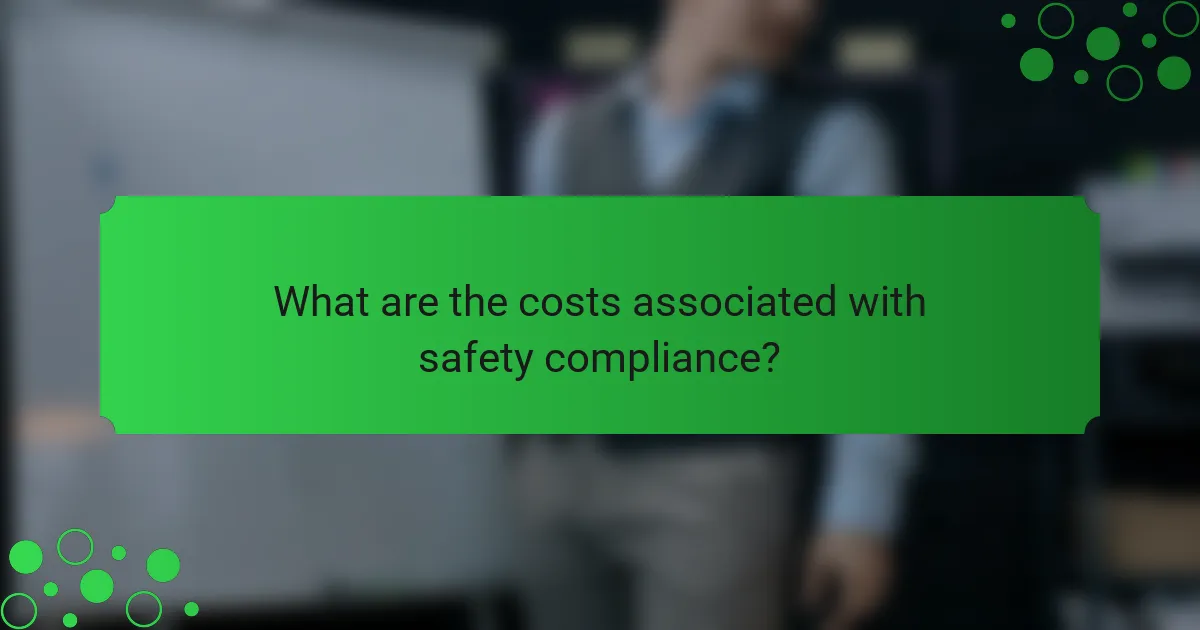
What are the costs associated with safety compliance?
The costs associated with safety compliance can vary widely depending on the industry, the size of the organization, and the specific regulations in place. Key expenses typically include training programs, inspection and auditing fees, and ongoing maintenance of safety protocols.
Training program expenses
Training program expenses are a significant part of safety compliance costs. Organizations must invest in employee training to ensure that all staff are aware of safety protocols and procedures. Costs can range from a few hundred to several thousand dollars per employee, depending on the complexity of the training and the number of participants.
When budgeting for training, consider both initial training and ongoing refresher courses. It’s essential to choose programs that meet industry standards and effectively address the specific safety needs of your workforce.
Inspection and auditing fees
Inspection and auditing fees are another crucial aspect of safety compliance costs. Regular inspections are necessary to identify potential hazards and ensure adherence to safety regulations. Fees for third-party inspections can vary, typically ranging from hundreds to thousands of dollars, depending on the scope and frequency of the audits.
To manage these costs effectively, schedule inspections during off-peak times and consider bundling services with the same provider for potential discounts. Ensure that all findings are documented and addressed promptly to avoid additional costs related to non-compliance.
